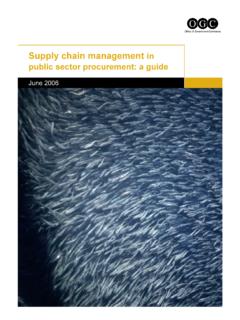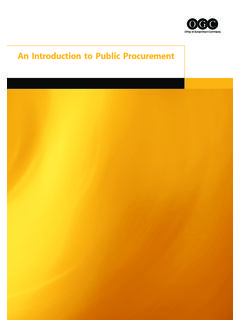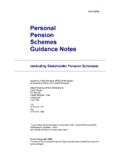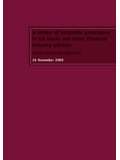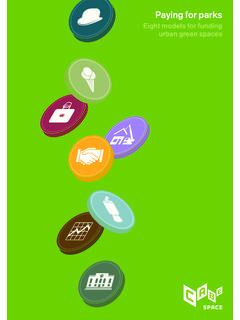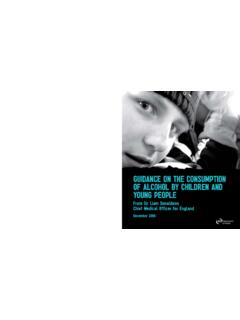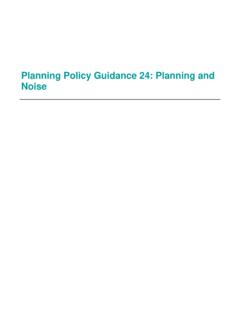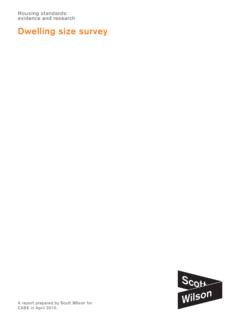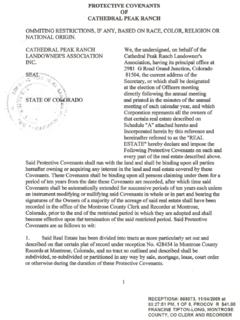Transcription of Technical Report - The National Archives
1 REVIEW OF CABLING TECHNIQUES. AND ENVIRONMENTAL EFFECTS. APPLICABLE TO THE OFFSHORE. WIND FARM INDUSTRY. Technical Report JANUARY 2008. IN ASSOCIATION WITH. Contents 1 Introduction 11. Background 11. Study Description 12. Report Format 13. 2 Legislation 15. Introduction 15. Licences and Consents 15. 3 Cable types and installation techniques 18. Introduction 18. Cable Types 18. Offshore Wind Farm Cables 18. Telecoms Cables 22. Power Cables 26. Flowlines, Umbilicals and Small Diameter Pipelines 27. Background to Safe Installation and Protection of Subsea Cables 27. Cable Protection Methods 34. Cable Protection for Offshore Wind Farm Developments 70. Burial Assessment and General Survey Techniques 77. Decommissioning 78. 4 Physical change 80. Introduction 80. Site Conditions 80. Level of Sediment Disturbance 82. Seabed Disturbance by Other Activities 89. Dispersal and Re-Deposition of Sediment 90. Mitigation Measures 99. 5 Potential impacts and mitigation measures 101. Introduction 101.
2 Subtidal Ecology 102. Intertidal Habitats 110. Natural Fish Resource 113. Commercial Fisheries 121. Marine Mammals 125. Ornithology 128. Shipping and Navigation 131. Seascape and Visual Character 133. Marine and Coastal Archaeology 134. 6 Good practice measures 138. 7 Gaps in understanding 140. 8 References 142. Appendix A: Standards and codes of practice relevant to cable installation & the Offshore wind industry 154. 1. Review of Cabling Techniques and Environmental Effects Applicable to the Offshore Wind Farm Industry Technical Report Acknowledgements This Report was prepared by consultants from Royal Haskoning and BOMEL. Ltd. The principal contributors from Royal Haskoning were Dr Samantha Vize, Christine Adnitt, Robert Staniland, Julia Everard, Alec Sleigh, Rod Cappell, Sean McNulty and Dr Martin Budd. From BOMEL Ltd, the principal contributors were Ian Bonnon and John Carey. This Report has benefited from assistance from Adrian Judd at the Centre of Fisheries, Environment and Aquaculture Science (CEFAS).
3 The authors also wish to thank the following consultees: Natural England (Louise Burton, Victoria Copley, Keith Henson, Sarah Soffe and Michael Young). English Heritage (Dr Chris Pater). Countryside Council for Wales (Dr Sarah Wood). Joint Nature Conservation Committee (Zoe Crutchfield and Andrew Prior). These consultees have assisted in providing comments on the principles of the study via correspondence. Their citation here does not indicate current agreement or support of the study outputs. The research leading to the publication of this Report was funded by: Department for Business, Enterprise and Regulatory Reform; and Department for Environment, Food and Rural Affairs. The project was managed by Dr John Hartley of Hartley Anderson Ltd on behalf of the Department Business, Enterprise and Regulatory Reform. The Target Audience This Report is intended to provide Technical details on subsea cable installation techniques and associated potential environmental effects, particularly relating to the offshore wind farm industry.
4 It aims to inform wind farm developers (and their consultants), stakeholders and regulators during the Environmental Impact Assessment (EIA) stage and consents process. 2. Summary In the UK today, wind farms are the most developed technology for the large scale production of renewable energy offshore. Given their position away from land-based urban development, offshore wind farms can be more substantial in terms of their area and power generation, compared to their land- based counterparts. Public support for offshore wind farms is generally high, particularly where evidence is presented through the formal consenting and consultation processes that developments are sited in an appropriate location, where environmental and negative economic effects are minimal or can be effectively managed. Integral to offshore wind farm development is the installation, operation and maintenance of the supporting electrical infrastructure of intra-array and export cables. This document aims to provide an information resource, intended for use by wind farm developers, consultants and regulators, on the range of cable installation techniques available, their likely environmental effects and potential mitigation, drawing on wind farm and other marine industry practice and experience.
5 Through the collation of existing information and experience from a range of sources, the Report will assist government, developers, stakeholders and regulators during the formal Environmental Impact Assessment and consenting process including stages of information provision, review and approval of such information. Importantly, an understanding of the difficulties and constraints of cable installation has been provided such that impacts can be avoided, reduced or minimised. This document also deals with the practical application of the installation and mitigation techniques available to developers so that the most relevant and up-to-date technology can be applied in the most appropriate situation. This document covers: The range of types of cables and small diameter pipelines currently installed in the EU shelf marine environment. Details are given for the types of cable typically used for offshore wind farms and also the types of cable commonly used in the telecommunications and power cable industries.
6 The range of techniques used to install and maintain the aforementioned cables and pipelines. Information is provided on a range of commonly applied cable protection measures, and also of the burial assessment survey techniques, commonly used before cable installation. The physical changes or effects to the seabed and sub-surface sediments expected to occur during cabling activities. The range of sediment types likely to be encountered during cable burial operations is discussed, with the level of sediment disturbance that is likely to occur during cable burial for each technique. 3. Review of Cabling Techniques and Environmental Effects Applicable to the Offshore Wind Farm Industry Technical Report The potential environmental impacts that could occur during the installation and maintenance of subsea cables. Impacts are described and discussed for intertidal habitats, subtidal ecology, natural fish resources, commercial fisheries, marine mammals, ornithology, shipping and navigation, seascape and visual character, and marine and coastal archaeology.
7 Impacts are divided into those that could cause potentially significant impacts and those that may arise but are unlikely to cause significant effects. Mitigation measures that can be used to reduce the level of significance of environmental effects. Examples of good practice measures that could be adopted during all phases of project planning and used in conjunction with mitigation measures to reduce potential disturbance from cabling activities; and Knowledge gaps identified during this review, including gaps in understanding of the actual environmental impacts resulting from cable burial activities. The key impacts relating to cable laying in the marine environment occur during the installation process. Cable burial and other protection measures ( outer protective cable armouring, concrete and frond mattresses, rock dumping, and grout / sand bags) are used in order to reduce the risk of damage to the cable and to ensure the safety of other users of the sea. Where cables are not afforded adequate protection, damage can occur through abrasion ( on rocky seabed types) and interaction with human activities such as snagging or entanglement from bottom trawl fishing gear, anchoring or navigational dredging.
8 Dependant upon prevailing conditions of depth, seabed morphology, hydrodynamics and geology, a range of cable burial technology is available to developers, such as cable ploughs, tracked burial machines, free swimming remotely operated vehicles (ROVs) and burial sleds. Induced changes to the prevailing physical conditions of an area, such as the suspension, dispersal and subsequent deposition of seabed sediments, changes to seabed morphology and the direct impacts associated with the presence and operation of cable burial equipment can lead to a range of potential environmental impacts. The nature, extent and significance of these impacts will be a function of site specific characteristics ( seabed type, tidal and wave conditions) and the chosen installation method. The key potential environmental impacts, which can, in specific circumstances, be associated with cable burial, include: Disturbance to sessile, encrusting, and attached fauna and flora which can be dislodged/disturbed.
9 Smothering of sessile species due to increased sediment deposition and side- cast;. Damage to the filtering mechanisms of certain species, the gills of sensitive fish species and eggs and larvae from increases in suspended sediment and subsequent deposition;. 4. The potential release of contaminants, previously retained in the sediment;. Disturbance to important fisheries habitats such as spawning grounds, nursery grounds, feeding grounds, over-wintering areas for crustaceans, migration routes and shellfish beds;. Disturbance to sensitive habitats, such as saltmarshes, biogenic reefs and eel grass beds;. Noise and vibration impacts to fish and marine mammals;. Electromagnetic field generation impacts to benthic species, fish and marine mammals;. Risk of collision of marine mammals with cable installation vessels / support vessels; marine mammals may be disturbed by the presence of vessels and cable burial equipment; and, cable entanglement with marine mammals;. Marine and coastal bird species, particularly at sites of importance to nature conservation, may be disturbed by the presence of vessels and human activities.
10 Navigational risks such as collision with cable installation vessels;. Direct loss or disturbance to artefacts of importance to marine and coastal archaeology and cultural heritage; and Seascape and visual impacts related to the cable installation activities and the presence of cable installation vessels; and possible sea surface aesthetic effects arising from sediment plumes, particularly in areas of chalk bedrock. This study concludes that, although cabling can cover large areas of seabed, the associated environmental impacts are highly transitory, localised in extent and temporary in duration. Although the corridor for cable installation impacts can be long, the footprint of impact is narrow, generally restricted to 2-3m width. For the majority of installation scenarios, the seabed and associated fauna and flora would be expected to return to a state similar to the pre-disturbance conditions. Exceptions could occur in hard clays and rock seabed types, where the cable trench would not naturally backfill, requiring intervention to backfill as part of construction works or else leaving permanent scarring of the seabed.
